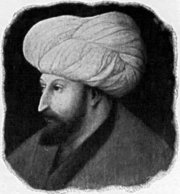Mehmed II
|
|
Mehmed II, also known as Muhammed II (March 30, 1432 – May 3, 1481; also known as el-Fatih, 'the Conqueror') was the sultan of the Ottoman Empire for a short time from 1444 to 1446, and later from 1451 to 1481. He was also the first Ottoman ruler to claim the title of Caesar of the Roman Empire (supreme ruler of all Christians), besides such usual titles as king, sultan (ruler of a Muslim state), Han or Khan (ruler of Turks), etc.
During his first reign, seeing the upcoming Battle of Varna, Mehmed sent for his father, Murad II, asking him to claim the throne again to fight the enemy, only to be refused. Enraged at his father, who had long since retired to a contemplative life in southwestern Anatolia, Mehmed wrote: "If you are the sultan, come and lead your armies. If I am the sultan I hereby order you to come and lead my armies." It was upon this letter that Murad II led the Ottoman army in the Battle of Varna in 1444.
Two years after reclaiming the throne in 1451, Mehmed brought an end to the Byzantine Empire by capturing Constantinople in 1453 (during the well-known Siege of Constantinople), and other Byzantine cities left in Anatolia and the Balkans. The invasion of Constantinople and successful campaigns against small kingdoms in the Balkans, Crimea, and Turkic territories in Anatolia bestowed immense glory and prestige on the country and the Ottoman State started to be recognized as an empire for the first time. Mehmed's advance toward the heart of Europe was stopped by the unsuccessful Siege of Nándorfehérvár in 1456, however.
His reign, mostly known for his capture of Constantinople, is also well known for the unusual tolerance with which he treated his subjects, especially among the conquered Byzantines. Within the vanquished city he established a millet or an autonomous religious community, and he appointed the former Patriarch as essentially governor of the city. However, his authority extended only unto the Orthodox Christians of the city, and this excluded the Genoese and Venetian settlements in the suburbs, and excluded the coming Muslim and Jewish settlers entirely. This method allowed for an indirect rule of the Christian Byzantines and allowed the occupants to feel relatively autonomous even as Mehmed began the Turkish remodeling of the city, eventually turning it into the Turkish capital, which it remained until the 1920s.
Mehmed thought of himself as the heir to the throne of the Roman Empire - which, technically, he was after capturing Constantinople - and, as a result, adopted the title "Kayser-i-Rüm" (Roman Caesar) and invaded Italy in 1480. The intent of his invasion was to capture Rome and reunite the Roman Empire for the first time since 751, and, at first, looked like he might be able to do it with the easy capture of Otranto in 1480. However, a rebellion in Albania later in 1480 cut into his military links, allowing a massive force led by the Pope to defeat and evict his army in 1481. Administratively, Mehmed was better at continuing the old Byzantine ways, as he gathered Italian humanists and Greek scholars at his court, kept the Byzantine Church functioning, ordered the patriarch to translate the Christian faith into Turkish and called Gentile Bellini from Venice to paint his portrait.
He is also recognized as the first sultan to codify criminal and constitutional law long before Suleyman the Magnificent (also "the Lawmaker" or "Kanuni") and he thus established the classical image of the autocratic Ottoman sultan (padishah). After the fall of Constantinople, he founded many universities and colleges in the city, some of which are still active.
It is also known that he spoke about seven languages when he was 21 years old (the age he conquered Istanbul) and it should be also mentioned that the prophet of Islam praised the conqueror of Istanbul by a quote. There is some evidence that Mehmed was the lover of the Wallachian prince Radu the Handsome.
His tomb is located at Fatih Mosque in Istanbul.
| Preceded by: Murad II | Ottoman Sultan | Succeeded by: Beyazid II |
de:Mehmed II. et:Mehmed II fr:Mehmed II hu:II. Mehmed nl:Mehmed II ja:メフメト2世 fi:Mehmed II sv:Mehmet II tr:Fatih Sultan Mehmet ar:محمد الفاتح zh:穆罕默德二世 (奥斯曼帝国)

